B2B Demand Generation: Your Growth Playbook
October 25, 2025
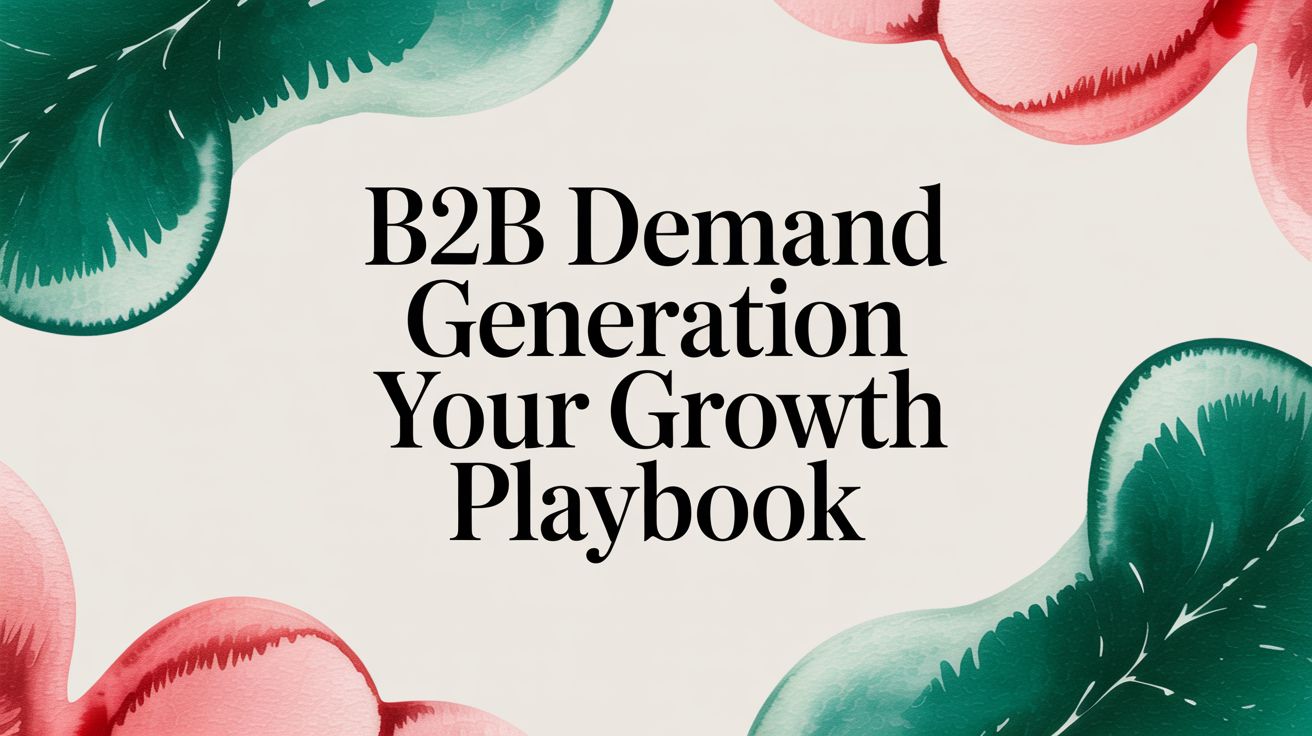
Forget the old-school marketing playbook. B2B demand generation isn't about chasing down contacts or blasting out cold emails. It’s the art of making your ideal customers want your solution, often before they’ve even defined the problem.
Think of it as playing the long game. You're not just looking for a quick win; you're focused on creating genuine awareness and establishing your brand as the go-to expert in your field. The goal is to shift from hunting for prospects to building an audience that actively seeks you out.
What Is B2B Demand Generation Really?
True B2B demand generation is the strategic process of creating awareness and deep interest in your company's solutions. It's about being so consistently helpful that when a buyer is finally ready to make a purchase, your brand is the only one they seriously consider.
Imagine you're a guide for a challenging mountain expedition. Instead of just setting up a booth at the trailhead shouting "Hire me!" (which is a bit like lead generation), you spend months creating the most useful maps of the area. You write insightful guides on navigating the terrain and host workshops on survival skills.
Over time, aspiring climbers start seeking you out for advice. They trust your expertise and see you as the authority, long before they’re ready to actually book their trip. That’s demand generation in a nutshell.
From Chasing Contacts to Creating Communities
This approach completely reframes your marketing philosophy. It stops being about capturing an email address at all costs. Instead, you're building a community around a shared challenge and positioning your business as the essential resource for solving it.
This shift is critical because the modern B2B buyer's journey is messy and mostly self-directed. Buyers do a ton of research on their own, and your goal is to be the most helpful, insightful voice they encounter along the way. You aren't just selling a product; you're educating an entire market.
The core idea is to let prospects know you’re there with consistent, valuable messaging. By delivering free solutions and sharing educational resources that support their business needs, they will naturally come to you when they’re ready to buy.
The Critical Difference: Demand vs. Leads
It's easy to get demand generation mixed up with its more aggressive cousin, lead generation. While you absolutely need both, they play very different roles in your funnel.
Think of it this way:
- Demand Generation is the act of creating interest in the first place. It’s about making people aware a better way of doing things exists.
- Lead Generation is the act of capturing that interest once it exists, usually through things like contact forms or gated content.
We've found that a lot of B2B marketers struggle to separate these two concepts, which can lead to mismatched strategies and metrics. To help clear things up, here’s a breakdown of the key differences:
Demand Generation vs Lead Generation Key Differences
Ultimately, a demand-first approach builds a much stronger, more predictable pipeline. The leads it eventually produces are warmer, more educated, and already have a genuine affinity for your brand before they ever talk to sales. For a deeper dive into the mechanics of capturing interest, check out our complete guide on B2B lead generation.
This is why content marketing is such a fundamental pillar of any solid demand gen strategy. A recent analysis shows a staggering 85% of B2B marketers plan to use content to generate leads in 2025, a clear signal of its power in building both awareness and trust. You can learn more about how content drives lead generation at ExplodingTopics.com.
By focusing on demand, you're not just temporarily filling the top of your funnel—you're building a foundation for sustainable, long-term growth.
Building Your Strategic Demand Generation Framework
A powerful B2B demand generation engine doesn’t just happen. It’s built with a precise blueprint. This framework is your strategic guide, turning abstract marketing ideas into an executable plan that consistently attracts your perfect customers. Think of it as the architecture supporting every piece of content, every campaign, and every conversation you have.
Without this structure, you’re just throwing tactics at the wall, hoping something sticks. But with it, you create a cohesive system where each activity builds on the last, guiding potential customers on a seamless journey from awareness to consideration. The goal is to build trust and authority long before a sales conversation ever happens.
Start with Your Ideal Customer Profile
Before you can generate demand, you have to know exactly who you're creating it for. This is where your Ideal Customer Profile (ICP) comes in. An ICP is a crystal-clear, data-backed description of the type of company that gets the most value from your product—and, in turn, provides the most value to your business.
This goes way beyond basic firmographics like company size or industry. A truly useful ICP digs into the core challenges, strategic goals, and buying processes of your target accounts. The best way to build one? Start by analyzing your best existing customers. Pinpoint their common traits, their biggest pain points, and the specific problems your solution absolutely nails for them.
A well-defined ICP is your north star. It ensures every marketing dollar and every ounce of effort is hyper-focused on the right audience, which dramatically improves the quality of interest you generate and makes your entire strategy more efficient.
Map the Entire Buyer Journey
Once you know who you're targeting, you need to understand how they buy. The B2B buyer's journey is rarely a straight line. It’s a complex, winding path with multiple stakeholders, endless research, and dozens of touchpoints. Mapping this journey is critical for creating content and experiences that actually resonate at each stage.
This visualization shows the fundamental flow, starting from the moment a prospect first realizes they have a problem, through their growing interest, and finally to their desire for a specific solution like yours.
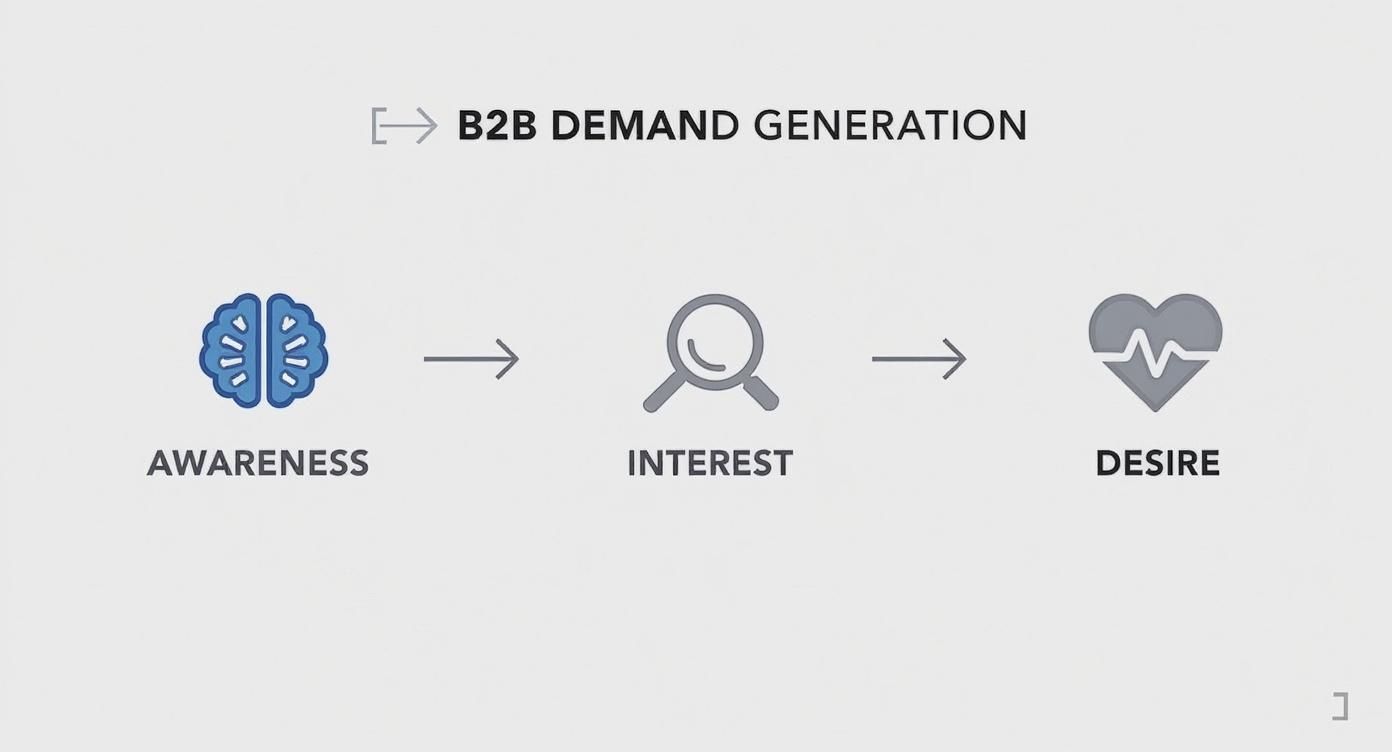
This process makes it clear that you need different types of content and engagement strategies as a prospect moves from being simply problem-aware to actively seeking a solution. Your framework has to account for these distinct phases to have any real impact.
Align Marketing and Sales from Day One
One of the most common—and catastrophic—points of failure in any B2B demand generation program is the gap between marketing and sales. Let's be clear: true alignment is non-negotiable. Both teams have to operate from a single source of truth, with shared definitions, goals, and a deep understanding of their respective roles.
This alignment needs to cover a few key areas:
- Shared ICP Definition: Both teams must agree on the exact profile of the company they're going after. No exceptions.
- Lead Handoff Process: You need a clear, agreed-upon process for when and how marketing-influenced accounts are passed to the sales team.
- Consistent Messaging: The story marketing tells has to be the same one sales uses in their conversations. Any inconsistency erodes trust and confuses potential buyers.
- Feedback Loops: Set up a system for regular communication. Sales needs to share insights from the field, and marketing needs to report back on campaign performance.
Building this collaborative foundation creates a seamless experience for the customer. It transforms the journey from a clunky handoff into a continuous, supportive conversation. This unified approach is a core part of a successful go-to-market strategy framework for B2B and is absolutely essential for turning demand into real revenue. With this framework in place, you’re finally ready to choose the channels that will bring your strategy to life.
Essential Channels for Driving B2B Demand
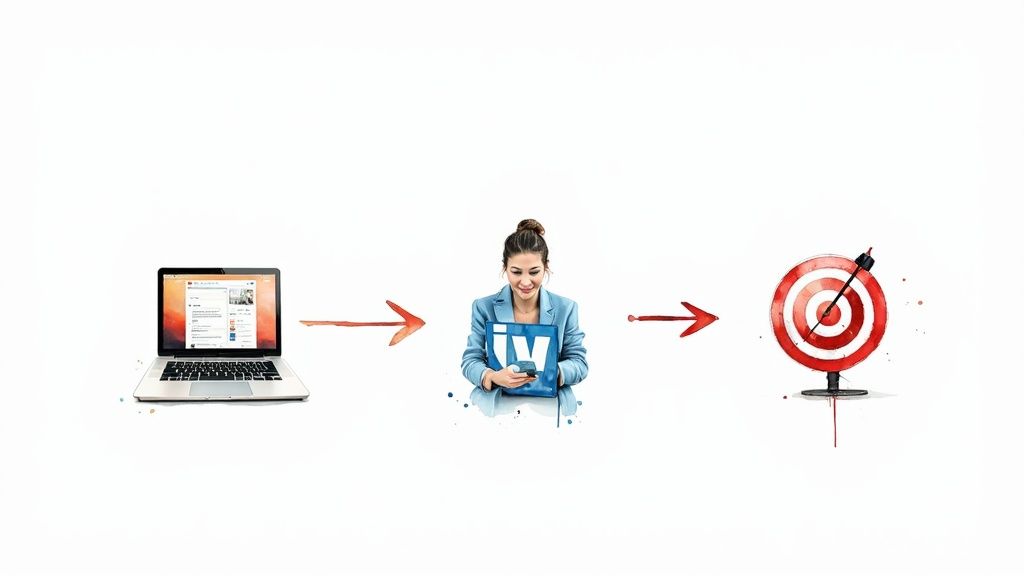
Choosing the right channels for your B2B demand generation strategy isn't about being everywhere—it's about being everywhere that matters. The goal is to figure out where your Ideal Customer Profile (ICP) hangs out online, where they hunt for information, and which professional communities they trust.
A truly potent demand engine isn't a one-trick pony. It’s a multi-pronged system where a few key channels work together to build awareness and spark genuine interest. Instead of a scattered "spray and pray" approach, you're creating a deliberate, focused presence where each channel has a specific job, whether that's capturing active buyers or warming up entire committees at your top accounts.
Educate and Inspire with Content Marketing
Content marketing is the absolute heart of B2B demand generation. It’s how you prove you know your stuff, solve real problems for your audience, and build trust long before a sales call is even a possibility. Think of your content less like a sales pitch and more like a public service for your industry.
When you consistently deliver value without asking for anything in return, you become a magnet for your ideal customers. This might be through insightful blog posts, deep-dive reports, or engaging webinars that tackle the biggest headaches your audience is dealing with. The objective is simple: become the go-to resource they can’t live without.
And the data backs this up. B2B marketers are all-in on this approach, with 83% of B2B content being created to build brand awareness and early-stage interest. Newer formats are especially popular right now—podcasts are favored by 77% of marketers, and blogs remain a powerhouse at 76%. It’s a clear shift toward educational, accessible content that builds a loyal following over time. You can learn more about how content formats impact demand from ExplodingTopics.com.
Capture Active Intent with SEO
While great content creates the desire for a solution, Search Engine Optimization (SEO) is how you catch that demand the second a buyer starts actively looking. When a prospect types their problem into Google, you absolutely have to be there with the answer. It’s the digital equivalent of being in the right place at precisely the right time.
But effective B2B SEO is much more than ranking for broad keywords. It’s about understanding the specific, nuanced questions your ICP is asking at every stage of their journey and creating targeted content that hits the nail on the head. This is how you position your company as the obvious solution when their need is most urgent.
SEO acts as a powerful qualifier. A prospect who finds you through a specific, problem-oriented search is often much further along in their buying process and has a higher intent than someone who stumbles across a social media post.
Target and Warm Up Entire Buying Committees
For those high-value, must-win accounts, a broad approach just won't cut it. This is where Account-Based Marketing (ABM) really shines, letting you treat each target company as its own unique market. It's a hyper-focused strategy designed to engage multiple stakeholders within your dream accounts all at once.
ABM completely flips the traditional funnel upside down. Instead of casting a wide net, you hand-pick a list of high-value companies and run personalized, orchestrated campaigns to get their entire buying committee familiar with your brand.
- LinkedIn Ads and Outreach: LinkedIn is your playground here. Run highly targeted ad campaigns aimed at specific job titles within your target accounts, and back it up with personalized outreach from your sales team to start building real relationships.
- Custom Content: Go the extra mile by developing content specifically for them, like a bespoke report or a webinar that speaks directly to the unique challenges of a single target company or their industry.
- Coordinated Plays: Get your sales and marketing teams working in lockstep. Marketing’s job is to warm up the account so that when sales finally reaches out, it’s not a cold call—it’s a welcome conversation.
This coordinated effort ensures that when your sales team does make contact, the key decision-makers are already nodding along, familiar with your brand and ready to listen. To pull all this together, you can explore our full guide on choosing the most effective B2B marketing channels for your specific goals.
Using Intent Data to Find Active Buyers

Imagine knowing which companies are ready to buy before they ever fill out a form on your site. That’s the game-changing power of intent data. It lets you stop guessing who might be interested and start knowing who is actively researching solutions just like yours, right now.
Think of intent data as the digital footprints companies leave all over the web. These signals—like a sudden spike in employees from one company reading articles on a specific topic or researching your top competitors—point to a growing need. For B2B demand generation, this information is pure gold.
Instead of shouting your message into the void, you can pinpoint the exact accounts that are in-market. This shifts your entire approach from a shot in the dark to a well-timed, relevant conversation with the right people at the perfect moment.
How to Decode Buyer Signals
Intent data comes in a few different flavors, and each one gives you a unique window into a prospect's mindset. When you understand the types of signals you're looking at, you can build a much clearer picture of who's on a buying journey and just how serious they are.
There are three main categories of signals to keep an eye on:
- First-Party Data: This is the data you collect yourself, directly from your own digital properties. Think website visits, content downloads, and pricing page views. It's the strongest signal out there because it shows direct engagement with your brand.
- Second-Party Data: Simply put, this is another company's first-party data that they share or sell to you. A great example is a tech publication sharing data on which companies are binge-reading articles related to your software category.
- Third-Party Data: This data is pulled together from thousands of websites across the internet. It provides a wide-angle lens on the topics and challenges companies are researching, often before they even know your brand exists.
By layering these data sources, you can build a remarkably accurate, multi-dimensional view of buyer interest. This comprehensive approach is a must for any modern, data-driven marketing strategy that’s serious about efficiency and impact.
Turning Insights into Actionable Campaigns
Once you've identified which accounts are in-market, the real fun begins. Now you can use that knowledge to tailor your outreach and make a real impact. This is where intent data stops being a cool concept and becomes a practical tool that drives serious pipeline growth for both marketing and sales.
Intent data removes the guesswork. It allows your sales and marketing teams to focus their energy on accounts that have a high probability of converting, dramatically improving the speed and quality of your pipeline.
This insight has become so fundamental to modern B2B marketing that it’s practically table stakes. In 2025, an incredible 98% of B2B marketers now say intent data is essential for finding ready-to-buy prospects and personalizing their campaigns. As buyers do more and more of their research before ever talking to a salesperson, being able to track these real-time signals is absolutely critical. You can discover more insights about demand generation trends on my-outreach.com.
Here are a few practical ways to put these signals to work:
- Prioritize Sales Outreach: Give your sales team a hot list of accounts showing high intent. This lets them jump straight into warm, relevant conversations instead of wasting time on cold calls.
- Launch Targeted Ad Campaigns: Run hyper-focused digital ad campaigns aimed only at the companies you know are actively looking for a solution like yours. No more wasted ad spend.
- Personalize Content Journeys: Serve up relevant blog posts, case studies, or webinar invites to accounts based on the specific topics they're already researching.
By acting on these signals, you create a more valuable and helpful experience for potential buyers. You’re no longer just another vendor; you’re the expert who showed up with the right answers at the right time.
Measuring What Matters for B2B Growth
In B2B demand generation, it's dangerously easy to mistake activity for progress. A flood of website traffic or a sudden spike in social media followers feels great, but these numbers rarely tell the whole story.
If you want to build a sustainable growth engine, you have to measure what actually matters—the metrics that draw a straight line from your marketing efforts to real business outcomes.
Shifting your focus from vanity metrics to meaningful Key Performance Indicators (KPIs) is what separates a marketing department from a revenue operation. It’s about building a dashboard that tells a clear, compelling story about how your program is creating tangible value and influencing the bottom line. This is how you prove your program's undeniable impact.
Moving Beyond Top-of-Funnel Noise
It’s tempting to get caught up in top-of-funnel metrics because they're right there in your face. Website sessions, content downloads, and social engagement are decent indicators of reach, but they are just the first chapter of a much longer story.
True B2B demand gen success is measured by how well you guide an entire buying committee through a complex journey, not just by how many individuals you attract at the start.
To get a clearer picture, you need to track metrics that signal genuine buying intent and qualification.
- Marketing Qualified Leads (MQLs): This classic metric tracks individuals who’ve shown enough interest to be considered a potential lead. The secret here is having a strict, mutually agreed-upon definition of "qualified" with your sales team.
- Sales Qualified Leads (SQLs): This shows how many of those MQLs the sales team accepts as legitimate opportunities worth their time. A healthy MQL-to-SQL conversion rate is a powerful sign of strong marketing and sales alignment.
- Account Engagement Score: Instead of just tracking individuals, start measuring engagement across an entire target account. This gives you a much more accurate view of interest, especially when multiple decision-makers are involved.
This evolution in measurement is becoming a necessity. Today, 34.5% of US B2B enterprise marketers report feeling more pressure than ever to demonstrate marketing ROI in real time. This is pushing companies to adopt more sophisticated attribution models to understand what's working and where to put their money.
Connecting Marketing Actions to Business Results
At the end of the day, the goal of any B2B demand generation program is to create predictable revenue growth. This requires connecting your top- and mid-funnel activities directly to the metrics your CEO and CFO actually care about. This is where you prove that marketing isn't a cost center, but a primary engine for business success.
These bottom-of-funnel KPIs are your proof points.
When you can clearly articulate how a blog post influenced a seven-figure deal or how a webinar series shortened the sales cycle, you completely change the conversation around marketing's value. You move from discussing budgets to discussing investments in growth.
Key business-level metrics include:
- Pipeline Velocity: How quickly are opportunities moving through your sales funnel? Faster velocity means your demand gen efforts are producing better-educated and more motivated buyers.
- Customer Acquisition Cost (CAC): What's the total cost of your sales and marketing efforts to acquire a new customer? An efficient demand program should steadily lower your CAC over time.
- Marketing-Influenced Revenue: This is the gold standard. It tracks the total revenue from deals that marketing touched in a meaningful way, proving your direct contribution to the company's success.
To really dial this in, using AI-powered business intelligence can give you a distinct advantage in understanding what's truly driving results.
The table below breaks down the most critical metrics to track at each stage of the funnel. Think of it as your cheat sheet for building a measurement framework that matters.
Key B2B Demand Generation Metrics by Funnel Stage
By focusing on these outcomes, you build an unshakeable case for your program’s value and secure its place as a core pillar of your organization’s growth strategy. For a deeper dive into this topic, you can explore our detailed guide on how to measure marketing effectiveness.
Time to Go Build Your Demand Engine
We’ve covered a lot of ground here, from the big-picture philosophy of creating desire all the way down to the nuts and bolts of building a framework, picking your channels, and measuring what actually moves the needle. You have the map.
But let’s be honest. B2B demand generation, when it’s done right, isn’t about just grabbing a bunch of tactics and hoping for the best. It’s a deep, almost obsessive commitment to understanding and serving your ideal customers. It’s about patiently becoming the go-to expert in your space, not just another vendor trying to make a sale.
When you make that mental switch, marketing stops being a cost center and starts becoming the engine of real, sustainable growth for your business.
It's a Long Game Built on Giving
The most powerful demand engines I’ve ever seen are built on a simple foundation: generosity.
They focus on giving value away—through ridiculously helpful content, insightful advice, and a genuine desire to solve problems—long before they ever ask for anything in return. That’s how you build an audience that doesn't just recognize your logo; they trust your expertise and look forward to hearing from you.
That’s the real endgame here. You want to build a system that pulls your ideal buyers toward you because you’ve become indispensable to them. It’s a shift from chasing leads to creating a gravitational pull around your brand.
Building a true demand engine is an investment in your brand's authority and your company's future. It takes patience and a rock-solid belief that helping your audience is the absolute best way to grow.
Your Next Move
You've got the blueprint now. The principles are clear: define your ideal customer, map out their world, create value at every turn, and measure the things that actually matter. Those are your building blocks.
The challenge isn't knowing what to do—it's having the discipline to do it, day in and day out, even when the results aren't immediate.
So, start small. Get focused. Commit to the process. Build your engine one piece at a time, learning and tweaking as you go. The reward for that consistency is a predictable, scalable flow of high-quality opportunities that will fuel your company for years. It's time to turn your marketing into an unstoppable force.
Frequently Asked Questions
When you start shifting from chasing leads to actually building an audience, a lot of questions pop up. It’s a totally different mindset. You're moving from short-term tactics to playing the long game—building a real asset for your business. Let's clear up a few common points that trip people up.
Think of this as a quick debrief before you head into the field. These are the things you need to know to avoid common mistakes and make sure your effort is going into what really moves the needle.
What Is the Biggest Mistake in B2B Demand Generation?
Hands down, the biggest mistake is confusing demand generation with its cousin, lead generation. It happens all the time. Companies get so obsessed with capturing contact info (leads) that they completely skip the part where they create genuine interest (demand).
This approach just short-circuits the whole process. You end up with a pipeline full of people who are barely aware of you, let alone interested in buying. Your sales team then wastes precious time on dead-end conversations, which tanks both efficiency and morale.
How Long Does It Take to See Results?
Look, this is a commitment, not a campaign. While you can spot early signs of life—like more website traffic, better content engagement, or a growing audience—within 3-6 months, the real business impact takes a bit longer.
For most B2B companies, especially if you have a long or complex sales cycle, you're probably looking at 6-12 months before you see a significant lift in qualified pipeline and revenue that marketing can take credit for. Patience and consistency are your best friends here.
The goal is to build an asset for your business—an audience that trusts you. This isn't a campaign with a start and end date; it's a fundamental shift in how you go to market. It's an investment that pays dividends over time.
Can Small Businesses Implement This Strategy?
Absolutely. In fact, having a smaller budget can be an advantage because it forces you to be hyper-focused. Small businesses can get incredible results by picking one or two channels where their Ideal Customer Profile lives and absolutely dominating them.
For example, you could create a series of incredibly detailed blog posts that solve one specific, painful problem for your audience. Then, promote the hell out of that content on LinkedIn. That's a powerful, budget-friendly way to start building authority and creating real demand.
How Do You Get Sales and Marketing Aligned?
Real alignment starts when both teams are chasing the same goals and speaking the same language. You need to sit down and agree on the nitty-gritty details:
- Who is our Ideal Customer Profile (ICP)? Be specific.
- What exactly is a Marketing Qualified Lead (MQL)?
- What makes it a Sales Qualified Lead (SQL)?
- What does the handoff process look like? No dropped batons.
Regular meetings are non-negotiable. Get both teams in a room to review what's working, share feedback from sales calls, and tweak the strategy together. High-quality content is often the glue that holds this all together. It's so critical that 84% of companies actually outsource content creation to make sure it's consistent and top-notch. You can find more stats on current B2B marketing trends on ExplodingTopics.com. This ensures both sales and marketing have the assets they need to win.
Ready to stop chasing leads and start building a real demand engine? At Big Moves Marketing, I specialize in creating the positioning and strategies that help B2B SaaS and AI startups drive adoption and revenue. Let's build a plan that turns your marketing into a predictable growth driver. Learn more and get in touch at Big Moves Marketing.
%20-%20Alternate.svg)
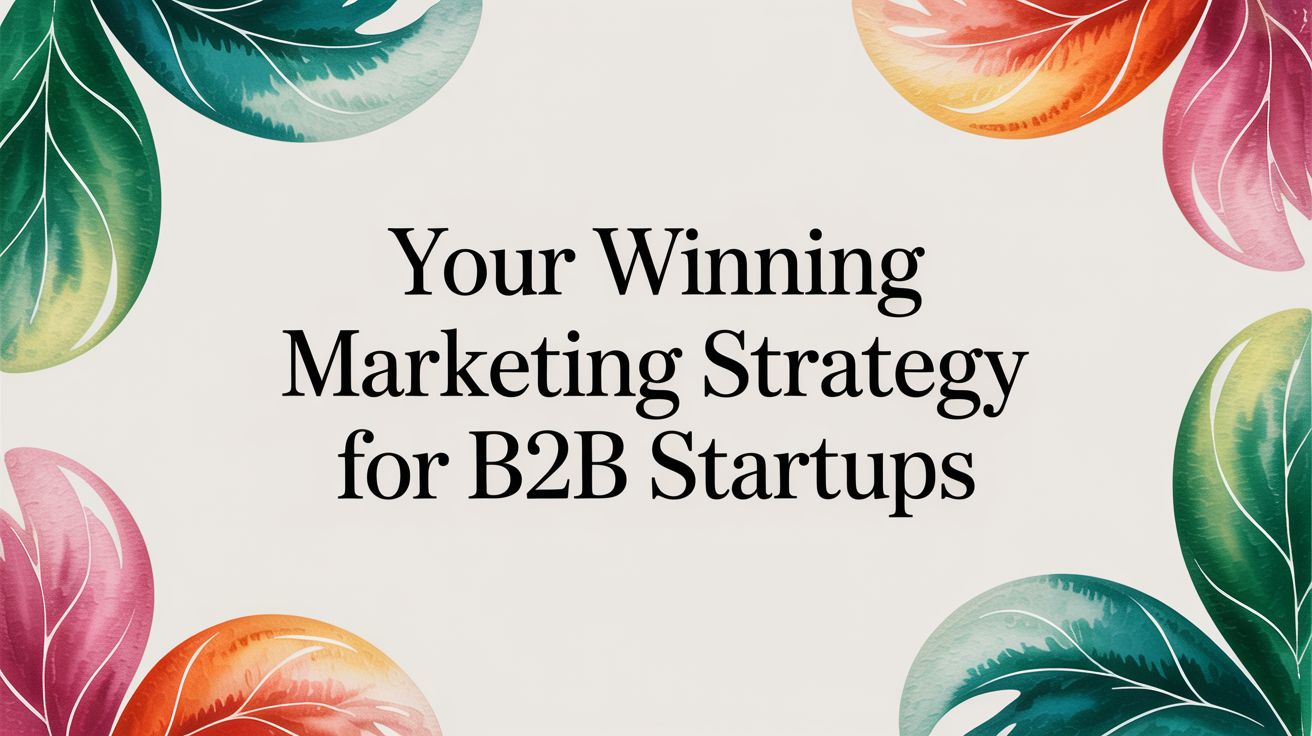
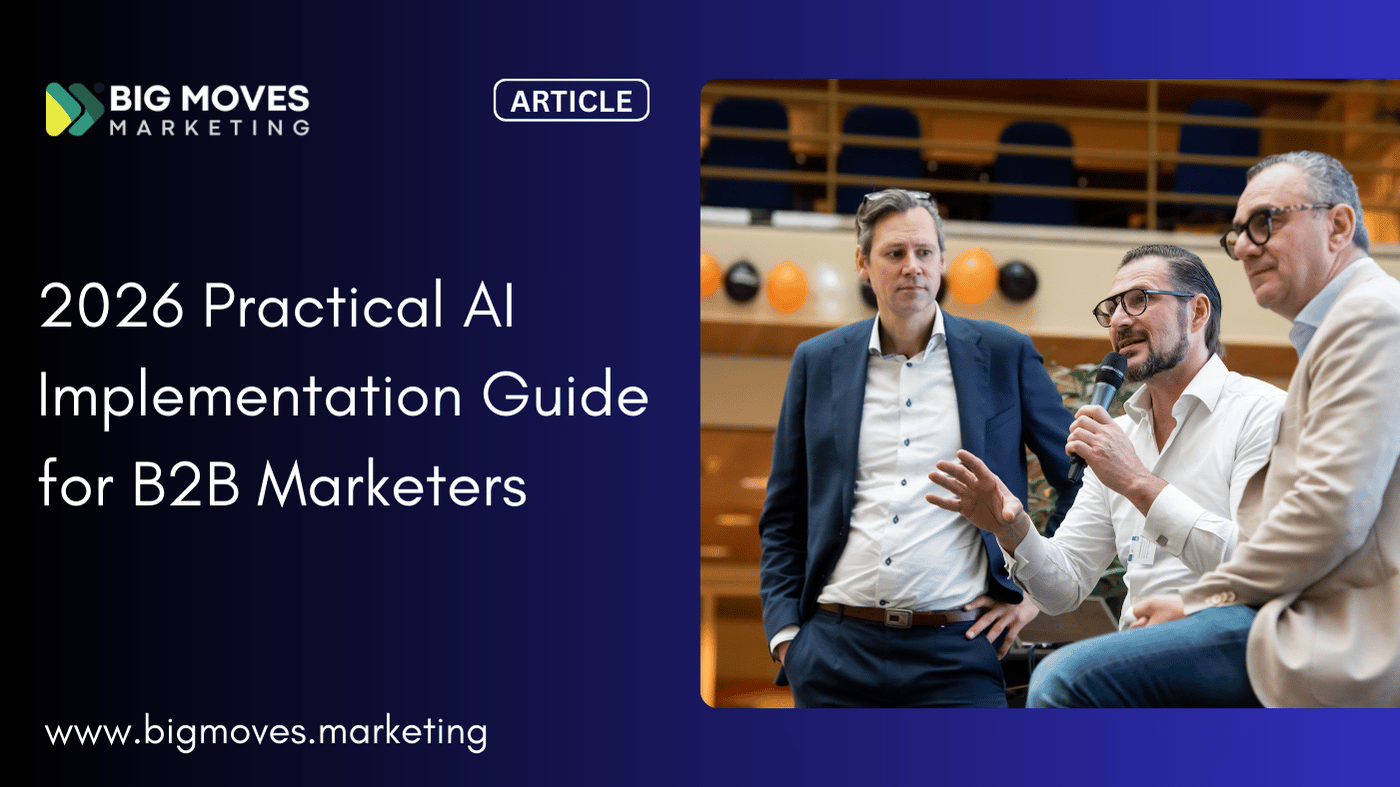
%20-%20white.svg)